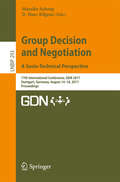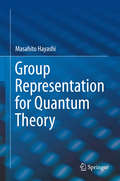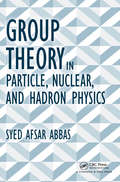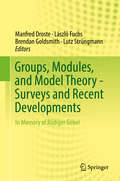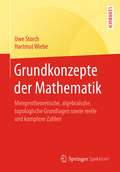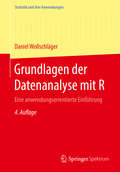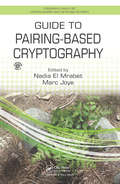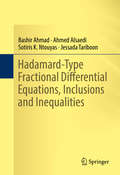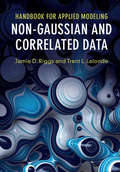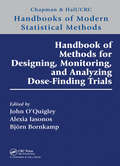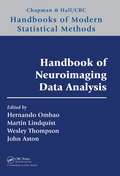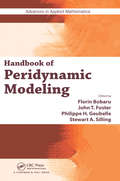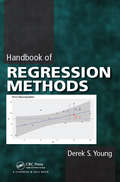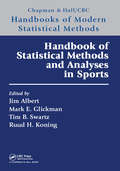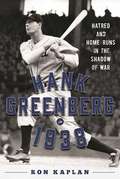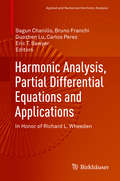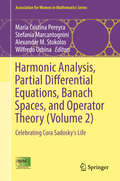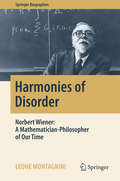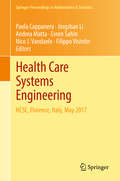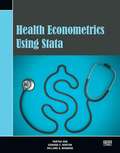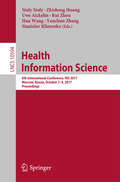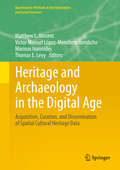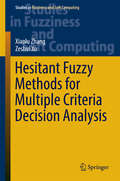- Table View
- List View
Group Decision and Negotiation. A Socio-Technical Perspective: 17th International Conference, GDN 2017, Stuttgart, Germany, August 14-18, 2017, Proceedings (Lecture Notes in Business Information Processing #293)
by D. Marc Kilgour Mareike SchoopThis book constitutes the refereed proceedings of the 17th International Conference on Group Decision and Negotiation, GDN 2017, held in Stuttgart, Germany, in August 2017. The field of Group Decision and Negotiation focuses on decision processes with at least two participants and a common goal but conflicting individual goals. Research areas of Group Decision and Negotiation include electronic negotiations, experiments, the role of emotions in group decision and negotiations, preference elicitation and decision support for group decisions and negotiations, and conflict resolution principles.The 14 full papers presented in this volume were carefully reviewed and selected from 87 submissions. They were organized in topical sections named: general topics in group decision and negotiation; conflict resolution; emotions in group decision and negotiation; negotiation support systems and studies; and preference modeling for group decision and negotiation. The book also contains two invited talks in full paper length.
Group Representation for Quantum Theory
by Masahito HayashiThis book explains the group representation theory for quantum theory in the language of quantum theory. As is well known, group representation theory is very strong tool for quantum theory, in particular, angular momentum, hydrogen-type Hamiltonian, spin-orbit interaction, quark model, quantum optics, and quantum information processing including quantum error correction. To describe a big picture of application of representation theory to quantum theory, the book needs to contain the following six topics, permutation group, SU(2) and SU(d), Heisenberg representation, squeezing operation, Discrete Heisenberg representation, and the relation with Fourier transform from a unified viewpoint by including projective representation. Unfortunately, although there are so many good mathematical books for a part of six topics, no book contains all of these topics because they are too segmentalized. Further, some of them are written in an abstract way in mathematical style and, often, the materials are too segmented. At least, the notation is not familiar to people working with quantum theory. Others are good elementary books, but do not deal with topics related to quantum theory. In particular, such elementary books do not cover projective representation, which is more important in quantum theory. On the other hand, there are several books for physicists. However, these books are too simple and lack the detailed discussion. Hence, they are not useful for advanced study even in physics. To resolve this issue, this book starts with the basic mathematics for quantum theory. Then, it introduces the basics of group representation and discusses the case of the finite groups, the symmetric group, e. g. Next, this book discusses Lie group and Lie algebra. This part starts with the basics knowledge, and proceeds to the special groups, e. g. , SU(2), SU(1,1), and SU(d). After the special groups, it explains concrete applications to physical systems, e. g. , angular momentum, hydrogen-type Hamiltonian, spin-orbit interaction, and quark model. Then, it proceeds to the general theory for Lie group and Lie algebra. Using this knowledge, this book explains the Bosonic system, which has the symmetries of Heisenberg group and the squeezing symmetry by SL(2,R) and Sp(2n,R). Finally, as the discrete version, this book treats the discrete Heisenberg representation which is related to quantum error correction. To enhance readers' undersnding, this book contains 54 figures, 23 tables, and 111 exercises with solutions.
Group Theory in Particle, Nuclear, and Hadron Physics
by Syed Afsar AbbasThis user-friendly book on group theory introduces topics in as simple a manner as possible and then gradually develops those topics into more advanced ones, eventually building up to the current state-of-the-art. By using simple examples from physics and mathematics, the advanced topics become logical extensions of ideas already introduced. In addition to being used as a textbook, this book would also be useful as a reference guide for graduates and researchers in particle, nuclear and hadron physics.
Groups, Graphs and Random Walks (London Mathematical Society Lecture Note Series #436)
by Tullio Ceccherini-Silberstein Maura Salvatori Ecaterina Sava-HussAn accessible and panoramic account of the theory of random walks on groups and graphs, stressing the strong connections of the theory with other branches of mathematics, including geometric and combinatorial group theory, potential analysis, and theoretical computer science. This volume brings together original surveys and research-expository papers from renowned and leading experts, many of whom spoke at the workshop 'Groups, Graphs and Random Walks' celebrating the sixtieth birthday of Wolfgang Woess in Cortona, Italy. Topics include: growth and amenability of groups; Schrdinger operators and symbolic dynamics; ergodic theorems; Thompson's group F; Poisson boundaries; probability theory on buildings and groups of Lie type; structure trees for edge cuts in networks; and mathematical crystallography. In what is currently a fast-growing area of mathematics, this book provides an up-to-date and valuable reference for both researchers and graduate students, from which future research activities will undoubtedly stem.
Groups, Modules, and Model Theory - Surveys and Recent Developments
by László Fuchs Manfred Droste Brendan Goldsmith Lutz StrüngmannThis volume focuses on group theory and model theory with a particular emphasis on the interplay of the two areas. The survey papers provide an overview of the developments across group, module, and model theory while the research papers present the most recent study in those same areas. With introductory sections that make the topics easily accessible to students, the papers in this volume will appeal to beginning graduate students and experienced researchers alike. As a whole, this book offers a cross-section view of the areas in group, module, and model theory, covering topics such as DP-minimal groups, Abelian groups, countable 1-transitive trees, and module approximations. The papers in this book are the proceedings of the conference "New Pathways between Group Theory and Model Theory," which took place February 1-4, 2016, in M#65533;lheim an der Ruhr, Germany, in honor of the editors' colleague R#65533;diger G#65533;bel. This publication is dedicated to Professor G#65533;bel, who passed away in 2014. He was one of the leading experts in Abelian group theory.
Grundkonzepte der Mathematik
by Uwe Storch Hartmut WiebeDieses Buch vermittelt wesentliche Grundlagen der Mathematik, und zwar aus der Mengenlehre, der Algebra, der Theorie der reellen und komplexen Zahlen sowie der Topologie. Es ist damit die Basis für eine weiterführende Beschäftigung mit der Mathematik. Nicht nur die nötigen Begriffe werden eingeführt, sondern bereits wesentliche – auch tieferliegende – Aussagen darüber bewiesen. Der Stoff wird durch ungewöhnliche Beispiele und vielfältige Aufgaben illustriert und ergänzt. Das Buch ist zum Selbststudium geeignet, aber vor allem konzipiert als Begleitlektüre von Anfang an für ein Studium der Mathematik, Physik und Informatik. Die stringente Herangehensweise macht es gut lesbar und vergleichsweise leicht verständlich.
Grundlagen der Datenanalyse mit R: Eine anwendungsorientierte Einführung (Statistik und ihre Anwendungen)
by Daniel WollschlägerDieses Buch liefert eine anwendungsorientierte Einführung in die Datenauswertung mit der freien Statistikumgebung R. Es behandelt deskriptive Auswertungen ebenso umfassend wie inferenzstatistische Analysen. Neben klassischen univariaten Verfahren berücksichtigt das Buch nonparametrische Tests, Resampling-Methoden und multivariate Statistik. Zudem deckt es die vielfältigen Möglichkeiten ab, Daten aufzubereiten und Diagramme zu erstellen. Die statistischen Verfahren werden anhand von Beispielen erläutert und an vielen Stellen mit Diagrammen illustriert.Das Buch richtet sich an alle, die R kennenlernen und in konkreten Aufgabenstellungen einsetzen möchten, ohne bereits über Vorerfahrungen mit befehlsgesteuerten Programmen oder Programmiersprachen zu verfügen. In die vierte Auflage sind sowohl die Neuerungen von R 3.3.2 als auch jüngere Entwicklungen bei den Zusatzpaketen eingeflossen. Gleichzeitig wurde der Text überarbeitet und um ein eigenes Kapitel zu Diagrammen mit ggplot2 erweitert. Der Text behandelt nun auch allgemeine numerische Methoden wie Nullstellensuche, numerische Integration und Ableitung sowie numerische Optimierung.
Guide to Pairing-Based Cryptography (Chapman & Hall/CRC Cryptography and Network Security Series)
by Nadia El Mrabet; Marc JoyeThis book is devoted to efficient pairing computations and implementations, useful tools for cryptographers working on topics like identity-based cryptography and the simplification of existing protocols like signature schemes. As well as exploring the basic mathematical background of finite fields and elliptic curves, Guide to Pairing-Based Cryptography offers an overview of the most recent developments in optimizations for pairing implementation. Each chapter includes a presentation of the problem it discusses, the mathematical formulation, a discussion of implementation issues, solutions accompanied by code or pseudocode, several numerical results, and references to further reading and notes. Intended as a self-contained handbook, this book is an invaluable resource for computer scientists, applied mathematicians and security professionals interested in cryptography.
Hadamard-Type Fractional Differential Equations, Inclusions and Inequalities
by Bashir Ahmad Ahmed Alsaedi Sotiris K. Ntouyas Jessada TariboonThis book focuses on the recent development of fractional differential equations, integro-differential equations, and inclusions and inequalities involving the Hadamard derivative and integral. Through a comprehensive study based in part on their recent research, the authors address the issues related to initial and boundary value problems involving Hadamard type differential equations and inclusions as well as their functional counterparts. The book covers fundamental concepts of multivalued analysis and introduces a new class of mixed initial value problems involving the Hadamard derivative and Riemann-Liouville fractional integrals. In later chapters, the authors discuss nonlinear Langevin equations as well as coupled systems of Langevin equations with fractional integral conditions. Focused and thorough, this book is a useful resource for readers and researchers interested in the area of fractional calculus.
Handbook for Applied Modeling: Non-Gaussian and Correlated Data
by Jamie D. Riggs Trent L. LalondeDesigned for the applied practitioner, this book is a compact, entry-level guide to modeling and analyzing non-Gaussian and correlated data. Many practitioners work with data that fail the assumptions of the common linear regression models, necessitating more advanced modeling techniques. This Handbook presents clearly explained modeling options for such situations, along with extensive example data analyses. The book explains core models such as logistic regression, count regression, longitudinal regression, survival analysis, and structural equation modelling without relying on mathematical derivations. All data analyses are performed on real and publicly available data sets, which are revisited multiple times to show differing results using various modeling options. Common pitfalls, data issues, and interpretation of model results are also addressed. Programs in both R and SAS are made available for all results presented in the text so that readers can emulate and adapt analyses for their own data analysis needs.
Handbook of Methods for Designing, Monitoring, and Analyzing Dose-Finding Trials
by Alexia Iasonos Björn Bornkamp John O'QuigleyHandbook of Methods for Designing, Monitoring, and Analyzing Dose-Finding Trials gives a thorough presentation of state-of-the-art methods for early phase clinical trials. The methodology of clinical trials has advanced greatly over the last 20 years and, arguably, nowhere greater than that of early phase studies. The need to accelerate drug development in a rapidly evolving context of targeted therapies, immunotherapy, combination treatments and complex group structures has provided the stimulus to these advances. Typically, we deal with very small samples, sequential methods that need to be efficient, while, at the same time adhering to ethical principles due to the involvement of human subjects. Statistical inference is difficult since the standard techniques of maximum likelihood do not usually apply as a result of model misspecification and parameter estimates lying on the boundary of the parameter space. Bayesian methods play an important part in overcoming these difficulties, but nonetheless, require special consideration in this particular context. The purpose of this handbook is to provide an expanded summary of the field as it stands and also, through discussion, provide insights into the thinking of leaders in the field as to the potential developments of the years ahead. With this goal in mind we present: An introduction to the field for graduate students and novices A basis for more established researchers from which to build A collection of material for an advanced course in early phase clinical trials A comprehensive guide to available methodology for practicing statisticians on the design and analysis of dose-finding experiments An extensive guide for the multiple comparison and modeling (MCP-Mod) dose-finding approach, adaptive two-stage designs for dose finding, as well as dose–time–response models and multiple testing in the context of confirmatory dose-finding studies.? John O’Quigley is a professor of mathematics and research director at the French National Institute for Health and Medical Research based at the Faculty of Mathematics, University Pierre and Marie Curie in Paris, France. He is author of Proportional Hazards Regression and has published extensively in the field of dose finding. Alexia Iasonos is an associate attending biostatistician at the Memorial Sloan Kettering Cancer Center in New York. She has over one hundred publications in the leading statistical and clinical journals on the methodology and design of early phase clinical trials. Dr. Iasonos has wide experience in the actual implementation of model based early phase trials and has given courses in scientific meetings internationally. Björn Bornkamp is a statistical methodologist at Novartis in Basel, Switzerland, researching and implementing dose-finding designs in Phase II clinical trials. He is one of the co-developers of the MCP-Mod methodology for dose finding and main author of the DoseFinding R package. He has published numerous papers on dose finding, nonlinear models and Bayesian statistics, and in 2013 won the Royal Statistical Society award for statistical excellence in the pharmaceutical industry. ? ?
Handbook of Neuroimaging Data Analysis (Chapman & Hall/CRC Handbooks of Modern Statistical Methods)
by John Aston Hernando Ombao Martin Lindquist Wesley ThompsonThis book explores various state-of-the-art aspects behind the statistical analysis of neuroimaging data. It examines the development of novel statistical approaches to model brain data. Designed for researchers in statistics, biostatistics, computer science, cognitive science, computer engineering, biomedical engineering, applied mathematics, physics, and radiology, the book can also be used as a textbook for graduate-level courses in statistics and biostatistics or as a self-study reference for Ph.D. students in statistics, biostatistics, psychology, neuroscience, and computer science.
Handbook of Peridynamic Modeling (Advances in Applied Mathematics)
by Florin Bobaru John T. Foster Philippe H. Geubelle Stewart A. SillingThis handbook covers the peridynamic modeling of failure and damage. Peridynamics is a reformulation of continuum mechanics based on integration of interactions rather than spatial differentiation of displacements. The book extends the classical theory of continuum mechanics to allow unguided modeling of crack propagation/fracture in brittle, quasi-brittle, and ductile materials; autonomous transition from continuous damage/fragmentation to fracture; modeling of long-range forces within a continuous body; and multiscale coupling in a consistent mathematical framework.
Handbook of Regression Methods
by Derek Scott YoungHandbook of Regression Methods concisely covers numerous traditional, contemporary, and nonstandard regression methods. The handbook provides a broad overview of regression models, diagnostic procedures, and inference procedures, with emphasis on how these methods are applied. The organization of the handbook benefits both practitioners and researchers, who seek either to obtain a quick understanding of regression methods for specialized problems or to expand their own breadth of knowledge of regression topics. This handbook covers classic material about simple linear regression and multiple linear regression, including assumptions, effective visualizations, and inference procedures. It presents an overview of advanced diagnostic tests, remedial strategies, and model selection procedures. Finally, many chapters are devoted to a diverse range of topics, including censored regression, nonlinear regression, generalized linear models, and semiparametric regression. Features Presents a concise overview of a wide range of regression topics not usually covered in a single text Includes over 80 examples using nearly 70 real datasets, with results obtained using R Offers a Shiny app containing all examples, thus allowing access to the source code and the ability to interact with the analyses
Handbook of Statistical Methods and Analyses in Sports (Chapman & Hall/CRC Handbooks of Modern Statistical Methods)
by Jim Albert Mark E. Glickman Ruud H. Koning Tim B. SwartzThis handbook will provide both overviews of statistical methods in sports and in-depth treatment of critical problems and challenges confronting statistical research in sports. The material in the handbook will be organized by major sport (baseball, football, hockey, basketball, and soccer) followed by a section on other sports and general statistical design and analysis issues that are common to all sports. This handbook has the potential to become the standard reference for obtaining the necessary background to conduct serious statistical analyses for sports applications and to appreciate scholarly work in this expanding area.
Handbuch Arbeits- und Gesundheitsschutz
by Institut für angewandte ArbeitswissenschDieses Handbuch dient als Praxisleitfaden für Arbeits- und Gesundheitsschutzbeauftragte. Es gibt Hilfestellung beim Aufbau der Organisation des betrieblichen Arbeits- und Gesundheitsschutzes. Dies soll Unternehmen dazu befähigen, basierend auf den gesetzlichen Anforderungen ein zum jeweiligen Betrieb passendes System zu installieren. Neben der rechtlichen Einordnung beschreiben die Autoren in kleinen Schritten und praxisgerecht die erforderlichen planerischen und organisatorischen Aspekte. Das Handbuch enthält Vorlagen und Checklisten. Diese können direkt verwendet und auf die eigenen betrieblichen Belange angepasst werden. Unternehmen, die das Handbuch nutzen und mit Leben füllen, haben damit die Grundlage für ein Arbeitsschutzsystem geschaffen, dass zu einem Arbeitsschutzmanagement ausgebaut werden kann. Dieses Handbuch wird Betriebspraktiker interessieren, ihnen hilfreiche Impulse für die eigene Arbeit sowie für die Umsetzung vor Ort geben.
Hank Greenberg in 1938: Hatred and Home Runs in the Shadow of War
by Ron Kaplan"Hammerin’” Hank Greenberg was coming off a stellar season where he’d hit 40 home runs and 184 RBIs, becoming only the thirteenth player to ever hit 40 or more homers (and one of only four players to have 40 or more home runs and 175 or more RBIs in a season). Even with his success at the plate, neither Greenberg nor the rest of the world could have expected what was about to happen in 1938. From his first day in the big leagues, the New York-born Greenberg had dealt with persecution for being Jewish. From teammate Jo-Jo White asking where his horns were to the verbal abuse from bigoted fans and the media, the 6-foot-3 slugger always did his best to shut the noise out and concentrate on baseball. But in 1938, that would be more difficult then he could have ever imagined.While Greenberg was battling at the plate, his people overseas were dealing with a completely different battle. Adolf Hitler, who had been chancellor of Germany since 1933, had taken direct control of the country’s military in February of ’38. He then began his methodic takeover of all neighboring countries, spreading Nazism and the early stages of World War II and the Holocaust.Hank Greenberg in 1938 chronicles the events of 1938, both on the baseball diamond and the streets of Europe. As Greenberg’s bat had him on course for Babe Ruth’s home run record, Hitler’s "Final Solution” was beginning to take shape. Jews across the US, worried about the issues overseas, looked to Greenberg as a symbol of hope. Though normally hesitant to speak about the anti-Semitism he dealt with, the slugger still knew the role he was playing for so many of his people, saying "I came to feel that if I, as a Jew, hit a home run, I was hitting one against Hitler.”
Harmonic Analysis, Partial Differential Equations and Applications
by Eric T. Sawyer Sagun Chanillo Bruno Franchi Guozhen Lu Carlos PerezThis collection of articles and surveys is devoted to Harmonic Analysis, related Partial Differential Equations and Applications and in particular to the fields of research to which Richard L. Wheeden made profound contributions. The papers deal with Weighted Norm inequalities for classical operators like Singular integrals, fractional integrals and maximal functions that arise in Harmonic Analysis. Other papers deal with applications of Harmonic Analysis to Degenerate Elliptic equations, variational problems, Several Complex variables, Potential theory, free boundaries and boundary behavior of functions.
Harmonic Analysis, Partial Differential Equations, Banach Spaces, and Operator Theory (Volume #2)
by Alexander M. Stokolos Wilfredo Urbina María Cristina Pereyra Stefania MarcantogniniThis book is the second of a two volume series. Covering a range of subjects from operator theory and classical harmonic analysis to Banach space theory, this book features fully-refereed, high-quality papers exploring new results and trends in weighted norm inequalities, Schur-Agler class functions, complex analysis, dynamical systems, and dyadic harmonic analysis. Graduate students and researchers in analysis will find inspiration in the articles collected in this volume, which emphasize the remarkable connections between harmonic analysis and operator theory. A survey of the two weight problem for the Hilbert transform and an expository article on the Clark model to the case of non-singular measures and applications to the study of rank-one perturbations are included. The material for this volume is based on the 13th New Mexico Analysis Seminar held at the University of New Mexico, April 3-4, 2014 and on several special sections of the Western Spring Sectional Meeting at the University of New Mexico, April 4-6,2014. During the event, participants honored the memory of Cora Sadosky--a great mathematician who recently passed away and who made significant contributions to the field of harmonic analysis. Cora was an exceptional scientist and human being. She was a world expert in harmonic analysis and operator theory, publishing over fifty-five research papers and authoring a major textbook in the field. Participants of the conference include new and senior researchers, recent doctorates as well as leading experts in the area.
Harmonies of Disorder
by Leone MontagniniThis book presents the entire body of thought of Norbert Wiener (1894-1964), knowledge of which is essential if one wishes to understand and correctly interpret the age in which we live. The focus is in particular on the philosophical and sociological aspects of Wiener's thought, but these aspects are carefully framed within the context of his scientific journey. Important biographical events, including some that were previously unknown, are also highlighted, but while the book has a biographical structure, it is not only a biography. The book is divided into four chronological sections, the first two of which explore Wiener's development as a philosopher and logician and his brilliant interwar career as a mathematician, supported by his philosophical background. The third section considers his research during World War II, which drew upon his previous scientific work and reflections and led to the birth of cybernetics. Finally, the radical post-war shift in Wiener's intellectual path is considered, examining how he came to abandon computer science projects and commenced ceaseless public reflections on the new sciences and technologies of information, their social effects, and the need for responsibility in science.
Health Care Systems Engineering
by Jingshan Li Andrea Matta Evren Sahin Nico J. Vandaele Paola Cappanera Filippo VisintinThis book presents statistical processes for health care delivery and covers new ideas, methods and technologies used to improve health care organizations. It gathers the proceedings of the Third International Conference on Health Care Systems Engineering (HCSE 2017), which took place in Florence, Italy from May 29 to 31, 2017. The Conference provided a timely opportunity to address operations research and operations management issues in health care delivery systems. Scientists and practitioners discussed new ideas, methods and technologies for improving the operations of health care systems, developed in close collaborations with clinicians. The topics cover a broad spectrum of concrete problems that pose challenges for researchers and practitioners alike: hospital drug logistics, operating theatre management, home care services, modeling, simulation, process mining and data mining in patient care and health care organizations.
Health Econometrics Using Stata
by Partha Deb Edward Norton Willard ManningHealth Econometrics Using Stataby Partha Deb, Edward C. Norton, and Willard G. Manning provides an excellent overview of the methods used to analyze data on healthcare expenditure and use. Aimed at researchers, graduate students, and practitioners, this book introduces readers to widely used methods, shows them how to perform these methods in Stata, and illustrates how to interpret the results. Each method is discussed in the context of an example using an extract from the Medical Expenditure Panel Survey. After the overview chapters, the book provides excellent introductions to a series of topics aimed specifically at those analyzing healthcare expenditure and use data. The basic topics of linear regression, the generalized linear model, and log and Box-Cox models are covered with a tight focus on the problems presented by these data. Using this foundation, the authors cover the more advanced topics of models for continuous outcome with mass points, count models, and models for heterogeneous effects. Finally, they discuss endogeneity and how to address inference questions using data from complex surveys. The authors use their formidable experience to guide readers toward useful methods and away from less recommended ones. Their discussion of "health econometric myths" and the chapter presenting a framework for approaching health econometric estimation problems are especially useful for this aspect. , count models, and models for heterogeneous effects. Finally, they discuss endogeneity and how to address inference questions using data from complex surveys. The authors use their formidable experience to guide readers toward useful methods and away from less recommended ones. Their discussion of "health econometric myths" and the chapter presenting a framework for approaching health econometric estimation problems are especially useful for this aspect.
Health Information Science: 6th International Conference, HIS 2017, Moscow, Russia, October 7-9, 2017, Proceedings (Lecture Notes in Computer Science #10594)
by Siuly Siuly, Zhisheng Huang, Uwe Aickelin, Rui Zhou, Hua Wang, Yanchun Zhang and Stanislav KlimenkoThis book constitutes the refereed proceedings of the 6th International Conference on Health Information Science, HIS 2017, held in Moscow, Russia, in October 2017.The 11 full papers and 7 short papers presented were carefully reviewed and selected from 44 submissions. The papers feature multidisciplinary research results in health information science and systems that support health information management and health service delivery. They relate to all aspects of the conference scope, such as medical/health/biomedicine information resources such as patient medical records, devices and equipments, software and tools to capture, store, retrieve, process, analyze, and optimize the use of information in the health domain; data management, data mining, and knowledge discovery, management of publichealth, examination of standards, privacy and security issues; computer visualization and artificial intelligence for computer aided diagnosis; development of new architectures and applications for health information systems.
Heritage and Archaeology in the Digital Age: Acquisition, Curation, And Dissemination Of Spatial Cultural Heritage Data (Quantitative Methods In The Humanities And Social Sciences Ser.)
by Thomas E. Levy Marinos Ioannides Matthew L. Vincent Víctor Manuel López-Menchero BendichoThis book examines how computer-based programs can be used to acquire ‘big’ digital cultural heritage data, curate, and disseminate it over the Internet and in 3D visualization platforms with the ultimate goal of creating long-lasting “digital heritage repositories.’ The organization of the book reflects the essence of new technologies applied to cultural heritage and archaeology. Each of these stages bring their own challenges and considerations that need to be dealt with. The authors in each section present case studies and overviews of how each of these aspects might be dealt with. While technology is rapidly changing, the principles laid out in these chapters should serve as a guide for many years to come. The influence of the digital world on archaeology and cultural heritage will continue to shape these disciplines as advances in these technologies facilitate new lines of research. serif">The book is divided into three sections covering acquisition, curation, and dissemination (the major life cycles of cultural heritage data). Acquisition is one of the fundamental challenges for practitioners in heritage and archaeology, and the chapters in this section provide a template that highlights the principles for present and future work that will provide sustainable models for digital documentation. Following acquisition, the next section highlights how equally important curation is as the future of digital documentation depends on it. Preservation of digital data requires preservation that can guarantee a future for generations to come. The final section focuses on dissemination as it is what pushes the data beyond the shelves of storage and allows the public to experience the past through these new technologies, but also opens new lines of investigation by giving access to these data to researchers around the globe. Digital technology promises significant changes in how we approach social sciences, cultural heritage, and archaeology. However, researchers must consider not only the acquisition and curation, but also the dissemination of these data to their colleagues and the public.Throughout the book, many of the authors have highlighted the usefulness of Structure from Motion (SfM) work for cultural heritage documentation; others the utility and excitement of crowdsourcing as a ‘citizen scientist’ tool to engage not only trained students and researchers, but also the public in the cyber-archaeology endeavor. Both innovative tools facilitate the curation of digital cultural heritage and its dissemination. Together with all the chapters in this volume, the authors will help archaeologists, researchers interested in the digital humanities and scholars who focus on digital cultural heritage to assess where the field is and where it is going.
Hesitant Fuzzy Methods for Multiple Criteria Decision Analysis
by Zeshui Xu Xiaolu ZhangThe book offers a comprehensive introduction to methods for solving multiple criteria decision making and group decision making problems with hesitant fuzzy information. It reports on the authors' latest research, as well as on others' research, providing readers with a complete set of decision making tools, such as hesitant fuzzy TOPSIS, hesitant fuzzy TODIM, hesitant fuzzy LINMAP, hesitant fuzzy QUALIFEX, and the deviation modeling approach with heterogeneous fuzzy information. The main focus is on decision making problems in which the criteria values and/or the weights of criteria are not expressed in crisp numbers but are more suitable to be denoted as hesitant fuzzy elements. The largest part of the book is devoted to new methods recently developed by the authors to solve decision making problems in situations where the available information is vague or hesitant. These methods are presented in detail, together with their application to different type of decision-making problems. All in all, the book represents a valuable reference guide for graduate students and researchers in the both fields of fuzzy logic and decision making.
